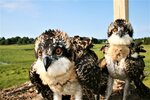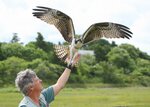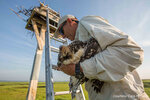






On Friday, March 20th, as most of us were just beginning to comprehend what “flattening the curve” meant, Diane Dondero of Salisbury was looking skyward through her binoculars at the distinctive long, crooked wings and black and white color pattern of three birds soaring high above the Merrimac River. “They’re back!” she thought to herself. It was the first reported osprey sighting of 2020 in Essex County. Those birds had just completed a 3,000-mile journey from their winter home in South America, a migratory pattern their species has repeated for thousands of years.
Two weeks later and 25 miles south, Linda and Douglas Pogson reported the arrival of a familiar pair of ospreys to a nest on a utility pole behind their home on the Saugus River. They have been observing Ollie and Olivia, as they affectionally call them, since 2011. In 2014, the Pogsons learned about the Essex County Greenbelt Association’s (ECGA) Osprey Program, and, shortly thereafter, became nest monitors for the program.
Today, ospreys (Pandion haliaetus) are a familiar summer resident of coastal Massachusetts, but as recently as 1970 the species was on the brink of extinction as a result of the unregulated use of pesticides, especially DDT. It owes its resurgence to environmental activism and collaboration between wildlife biologists and volunteers (sometimes called “citizen scientists”) like the Pogsons and Diane Dondero.
This is the story of the ospreys of Essex County and how their numbers increased from a single nesting pair in 1985 to 49 nesting pairs in 2019, in large measure due to the stewardship of the ECGA Osprey Program.
Ospreys are found on every continent except Antarctica. According to Dr. Alan F. Poole, author of “Ospreys: The Revival of a Global Raptor” (2019, Johns Hopkins University Press), approximately two-thirds of the worldwide nesting pairs are in North America, with by far the greatest concentration along the East Coast. “They are a highly adaptable species,” Dr. Poole told me, “that can move into human-dominated landscapes and still thrive.”
The osprey diet consists almost exclusively of live fish. In our area they most often feed on herring and menhaden that school near the surface. They will not scavenge on carrion like hawks and eagles. When a foraging osprey sees a school of fish, it hovers for a moment—wings beating slowly—before making its dive. It can actually dive into the water up to a half a meter deep, aided by its somewhat oily plumage.
What makes ospreys so uniquely accessible to human observation is their nesting behavior. According to Dr. Poole, “For almost half the year an osprey’s life is centered around its nest. Nest building is a pair activity with the males doing most of the gathering of nesting materials and the females most of the arranging” of sticks delivered by the males. Often these nests are out in the open on man-made platforms and many, including the one ECGA erected behind LobstaLand Restaurant in Gloucester, are documented 24/7 by webcams.
The female usually lays three eggs in April and does most of the egg sitting during the incubation period, while the male becomes her sole source of food. Chicks begin to hatch in June. The male now needs to catch enough fish to feed himself, the chicks, and the female, who tears the fish apart to present to the hatchlings. Thirty days after hatching, the chicks have grown to about 70 to 80 percent of their adult body mass, and more of their nutrition goes into feather development. Once the feathers have developed, wildlife biologists can safely remove chicks from the nest to apply ankle bands with unique tracking numbers. This can be a harrowing process as the parents react defensively, oblivious to the honorable intentions of the interloper.
By about the 50-day mark, the chicks enter the fledgling stage and begin exercising their wings and hopping about the nest. Soon thereafter, the female moves away from the nest, usually to a nearby perch. For a short time, the male continues to deliver fish to the fledglings, while they begin taking their first flights and fishing on their own without any training.
What happens next is nothing short of remarkable. First, the female departs alone for points south. After a brief transition period where the male is still tending the fledglings, he, too, heads south. For a period of up to two weeks, the fledglings are on their own, showing more independence from the nest and taking full responsibility for their own nutrition. Then, as if answering a clarion call from deep within their genetic memory, each of the fledglings begins its own solo trip south.
Biologists knew from years banding data that ospreys wintered in South America, but they knew precious little about their migration routes, the duration of the trip, and exactly where these birds wintered. By the 1990s, satellite telemetry and transmitter technology evolved to the point where it was possible to affix tiny radio transmitters to birds, and that was a game-changer.
Enter Rob Bierregaard, who as an undergraduate at Yale in 1971 got involved in a research project monitoring the recovery of ospreys in the early post-DDT era on Martha’s Vineyard. Later in his career, Rob began experimenting with the use of radio transmitters to track ospreys. Since 2000, he’s personally supervised the release of over 100 ospreys with radio transmitters and makes all of his data available on his website, ospreytrax.com. According to Dr. Poole, the most amazing insight from Rob’s data is “what an incredibly narrow highway most of the birds follow on their migrations, both ways. It’s like they’re on rails. No one would have predicted that.” They follow the coastline down to the Florida Keys, cross over to Cuba, then on to Hispaniola, finally crossing the Caribbean Sea to reach landfall in Venezuela, and then on to the Amazon Basin.
Rob’s data also helped him determine that first-year birds actually spend two winters in South America (what Rob calls a “gap year”) before returning north ahead of their second birthdays to begin seeking nesting sites and mates.
Dave Rimmer has been Director of Land Stewardship at ECGA since 2001. As a wildlife biologist and fishermen, he spent a lot of time on the waters of Essex County in the 1980s and 90s. His “ah-ha” moment came when he noticed a pair of ospreys nesting on a rickety old duck blind on the Merrimac River. In the middle of the nesting season, the weight of the nest collapsed the blind and he thought to himself, “someone ought to be thinking about these ospreys and putting up some nesting platforms.” That someone would one day be him.
Jerry Klima, a lawyer from Salisbury, was another early advocate for ospreys in Essex County. Back in 1998, National Grid planned to replace old power lines across the Merrimac between Newburyport and Salisbury with new steel towers. Jerry represented a group of private citizens objecting to National Grid’s plan and successfully convinced them to run the new lines under the river. When National Grid began taking down the old lines in 2000, Jerry convinced them to leave up a few poles and erect nesting platforms on them. “And, by god! the very next year, guess what?” Jerry told me, “Ospreys showed up and began building nests.”
In 2007, Dave Rimmer convinced ECGA to begin erecting nesting platforms, the first near its headquarters on the Cox Reservation in Essex. “I was curious about what was happening with ospreys all around the county,” Dave told me. “Where are they? How many are there? No one else seemed to be taking care of ospreys north of Boston. So, I started personally spending a lot of time trying to figure this out. Eventually, I realized I couldn’t do it on my own. I needed to recruit volunteers.”
The ECGA Osprey Program was officially launched in 2010. That year, the program monitored just 11 nesting pairs. In 2011, the platform at the Cox Reservation attracted a nesting pair (Allyn and Ethel). When the pair hatched its first brood in 2013, ECGA installed a webcam and the new chicks became online celebrities.
Since its inception, the program has erected dozens of nesting platforms and established a network of volunteers and nest monitors of approximately 25 people. In 2019, the number of nesting pairs grew to 49 (32 nesting on man-made platforms), 25 pairs produced eggs, and 59 fledglings were observed. The program has banded almost 200 hatchlings since 2013. Nest monitors like Douglas and Linda Pogson and Jerry Klima submit weekly reports on the nests they’re tracking.
The data collected by the program are shared widely among research biologists, including Rob Bierregaard, who was invited by Dave Rimmer to equip four first-year birds with radio transmitters in 2013 and 2014. The most noteworthy of the four birds was Flow, who was released in 2014 and migrated to Cuba, returning to New England in the spring of 2016. Flow made one more trip to Cuba and back before falling victim to predation in Virginia in the fall of 2017.
Why is it important to have a thriving osprey population in Essex County? According to all the biologists I interviewed, ospreys are a barometer for the health of an ecosystem. They thrive where the water is clean and the fish abundant. As Dave Rimmer put it, “As go osprey, so go our coastal ecosystems.”